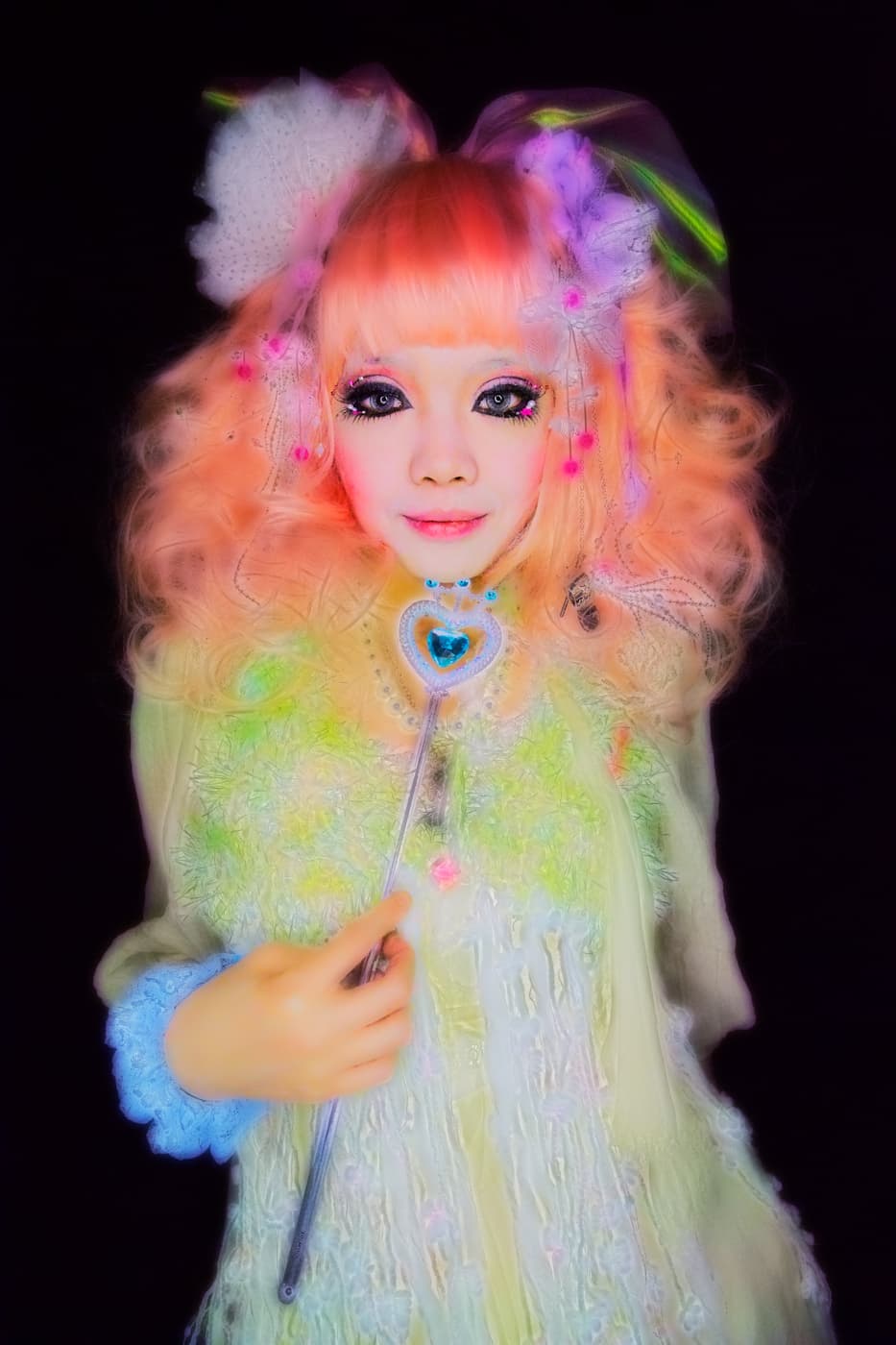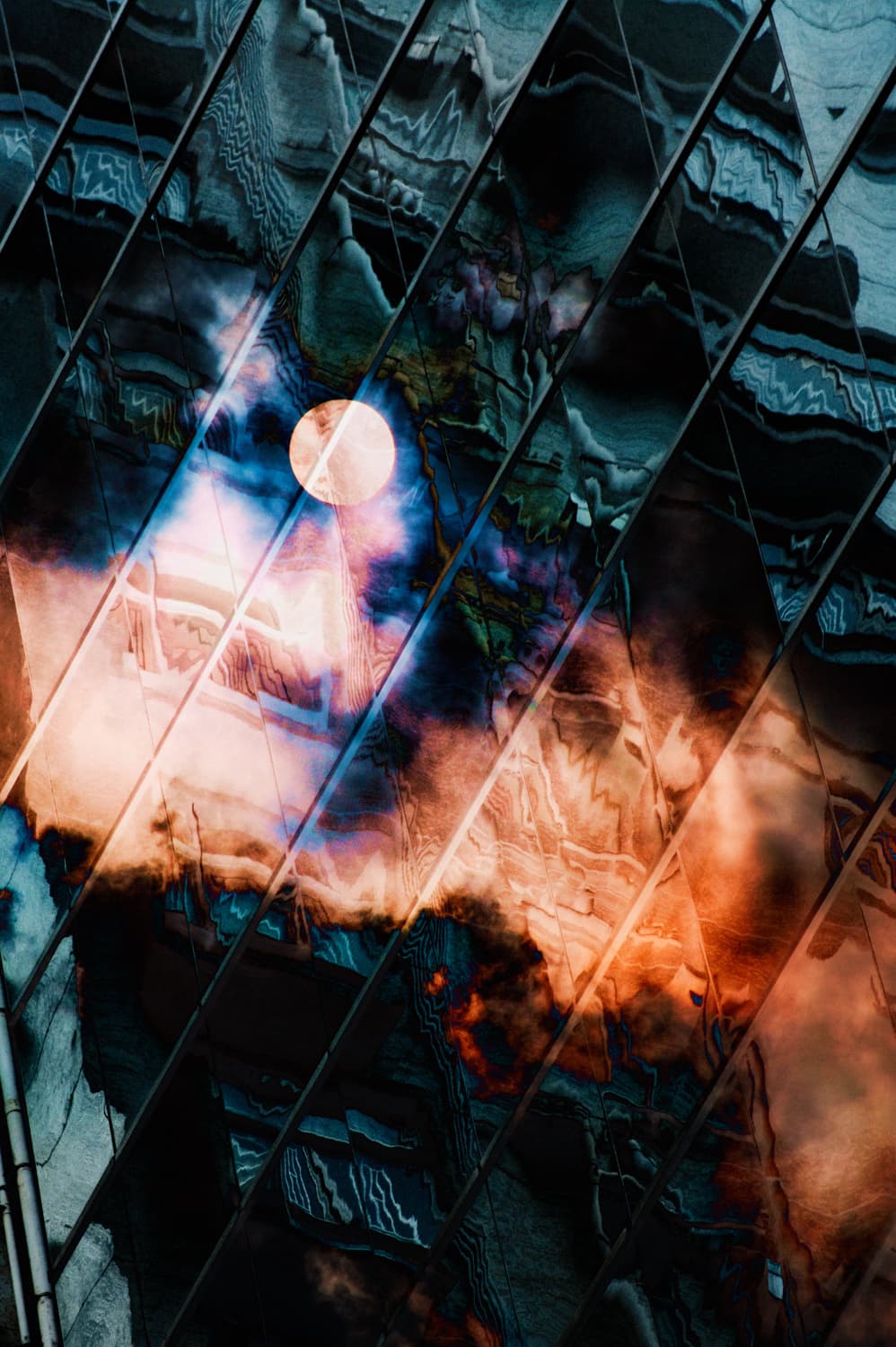Star of the Stars 福福星
Surely it is the emotions of the dead they are decking themselves out with.
Often the styles conceived by these people seem not so much cool as grotesque, with over-the-top colors and ornamentation.
I really can’t say why fashions like theirs have come about, although they remind me a bit of the gods of Buddhism or Hinduism.
As to what that something is, we might find one answer in the ideas of Kohei Sugiura, an outstanding graphic designer who is also a student of traditional Asian imagery. Sugiura observes that matou, one of the Japanese words for “to wear,” is synonymous with entering a state of possession where one takes on the very soul of what one has attired around one’s body. For example, tachiki (“standing tree”) designs on Japanese kimono depict cherry, plum, or other trees growing upward from hem to shoulder and spreading their branches and flowers out wide across the entire garment. By wrapping her body in this kimono with its riot of blossoms, a woman in effect turns into a tree herself.
According to Sugiura, the people of old were not very attached to their human status, and instead were much more drawn to the idea of taking on some other form of existence, such as that of a blossoming tree. Through this symbolic act of transformation, they sought to take onto themselves the latent energies of life and death pulsing within that tree. This kind of thinking has roots in the Asian belief that one’s life is a gift from one’s ancestors and from the myriad spirits residing in nature. When the self is acknowledged to be insignificant, then it becomes much easier for people to want to let themselves go and join the natural spirit world in the form of a cherry or plum tree.
⌜彼らはおそらく死者たちの感情で、自らを装飾している。⌟
彼らのファッションはクールというよりもグロテスクであったり、過剰な色彩、過剰な装飾のものが多いのです。なぜこんなファッションが現れるのか、ほんとうのところはよくわかりませんが、どことなく仏教の神々やヒンドゥー教の神々に似ているように思えてきます。・・・
ここは日本のすばらしいグラフィックデザイナーで東洋の図像を研究している杉浦康平さんの言葉に耳を傾けるべきでしょう。
「日本語の纏うということは憑依ということと同義でそのものの魂までも自分が纏うということになります。昔の人は自分が人間であるよりも、むしろ花盛りの木でありたいと願ったりしました。花盛りの木が秘めている生と死の情緒を我が身に帯びたいと願ったわけです。
例えば、 立木文様といわれる日本の着物は桜の木や梅の木の文様が縫い込まれて模様になっています。まさに百花繚乱の世界ですが、この着物を纏うことで、その女性は花盛りの木へと変身することになるといいます。
これは、東洋の考え方に自分は自分を生んだ祖先やありとあらゆる自然の中に宿る精霊によって生かされている、という考え方があるからなのです。自分というものはそんなにたいしたものじゃない、むしろ自然の霊の一部に変身したい、と願って桜の木になったり梅の木になったりするわけです。」
Phantom
Towns may come and go . . . but the well remains where it always was, thus explaining the phenomenon of successive towns built around the same sacred place, the spirit of which became the foundation deity, receiving the sacrifices offered in expiation of the crime of settlement and giving the law by which the city was governed. Implicit in this law was a contract between man and god by which the first was permitted a conditional use of land for agriculture and building in return for duties and observances paid to the second. So it was understood by the founding fathers of ancient cities. But as cities expand these limitations become more onerous and more neglected, with the result that, in the language of apocalypse, the holy city becomes Babylon, the parasitic whore, and proceeds to destruction.
(John Michell, The Earth Spirit: Its Ways, Shrines, and Mysteries, 1975)
次々に立て直される都市は、同じ聖地を敷地とし、そこに祀られる地霊が天地開闢の神となり、定住の罪を償うために捧げられた犠牲を受け取り、代わりにその都市を支える法を授けてきた。・・・神への忠誠と敬意を支払う見返りとして、土地の一部を農業と建築に使用することが許された。・・・しかし、都市が限度を超えて大きくなるにつれ、法の束縛は弱まり、ないがしろにされていった。その結果、黙示録の用語を借りれば、聖なる都市は自堕落な寄生の市(まち)バビロンとなって、破滅へ向かうのである。
「地霊 聖なる大地との対話」 ジョン・ミッシェル著 荒俣宏訳
SkyEarth: The Last Paradise
Every day I watched the sky and the sea of Funafuti. The god of Funafuti would gently blow on the surface of the clear blue and emerald green sea, and instantly the surface was carved into various shapes. Each moment, they sparkled like jewels in seven colors, only to quickly morph into other shapes. Those jewels were so beautiful they seemed to come from another world, but even the greatest fortune could not buy them. The god of Funafuti just laughs and shows off those stunning playful shapes to anyone who happens to be there watching, feeling the Tuvaluan breeze with their body. Whoever catches sight of such a jewel enjoys a luxury greater than any king or queen at that moment.
僕は毎日フナフチの空と海を見ていた。透きとおるようなブルーやエメラルドグリーンの海の表面にフナフチの神さまがそっと息を吹きかける。そうすると、その表面は様々な形に瞬間的に刻まれていく。一瞬一瞬、宝石のように7色に輝いては、すぐに別の形に変化していく。この宝石はこの世のものとも思われないほど美しいが、どんな巨万の富を持ってしても所有できない。その場にいて、ツバルの風をからだに感じながら目を凝らしている者にフナフチの神さまはその美しい遊びの形を笑いながら見せてくれる。その宝石を見たものはその瞬間、どんな王や女王よりもすばらしいぜいたくをあじわえるのだ。
Copyright by Yoichi Nagata. All rights reserved.



